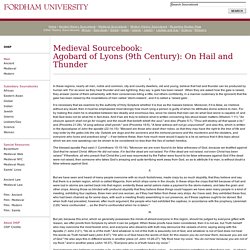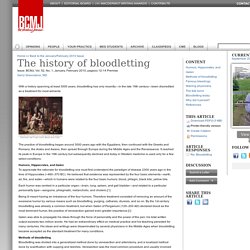

Agobard on Magonia - Jason Colavito. Internet History Sourcebooks Project. In these regions, nearly all men, noble and common, city and country dwellers, old and young, believe that hail and thunder can be produced by human will.

For as soon as they hear thunder and see lightning, they say ‘a gale has been raised’. When they are asked how the gale is raised, they answer (some of them ashamedly, with their consciences biting a little, but others confidently, in a manner customary to the ignorant) that the gale has been raised by the incantations of men called ‘storm-makers’, and it is called a ‘raised gale’. It is necessary that we examine by the authority of Holy Scripture whether it is true as the masses believe. Moreover, if it is false, as I believe without any doubt, then it must be emphasized most strongly how much lying a person is guilty of when he attributes divine actions to men.
And, to put it more clearly, truth has existence, or rather, existence is in its particular substance because truth subsists. Source. Translated by W. . © W. Notes: Pagan Survivals, Superstitions and Popular Cultures in Early Medieval ... - Bernadette Filotas, Pontifical Institute of Mediaeval Studies - Google Books. 10 Completely Uncanny Superstitions From The Middle Ages. Weird Stuff In the pre-scientific Middle Ages, the world was at the same time both fascinating and frightening.

In the absence of proper knowledge, people had no choice but to fall back on their own imaginations to make sense of the myriad natural phenomena around them. The result was a world where everything seemed magical, a place teeming with angels and demons, fairies and goblins, elves, gnomes, and witches. This list takes us inside the medieval mind and the fears and superstitions through which it tried to explain the world. 10 The Sea In The Sky For this story, we are indebted to English chronicler Gervase of Tilbury and his work Otia Imperiala. For proof, Gervase offers an episode that took place in an English village. Another tale concerns a merchant who accidentally dropped his knife while out at sea. 9 Omens Of Charlemagne’s Death The Frankish king Charlemagne was crowned Holy Roman Emperor in A.D. 800. 8 Magonia 7 Changelings.
The Complete History & Progression of Bloodletting. Let's say you just can't seem to wake up in the morning and you remain tired throughout the day.

You also experience aching joints and abdominal pain. Naturally, you visit your doctor, expecting to receive the typical lecture about eating right and exercising. Maybe they will write you a prescription to relieve your symptoms. But instead, your doctor asks a remarkable question that leaves you absolutely dumbfounded. "Have you considered bloodletting as a form of treatment? " Suddenly, you're thunderstruck. Well, yes. The history of bloodletting. With a history spanning at least 3000 years, bloodletting has only recently—in the late 19th century—been discredited as a treatment for most ailments.

The practice of bloodletting began around 3000 years ago with the Egyptians, then continued with the Greeks and Romans, the Arabs and Asians, then spread through Europe during the Middle Ages and the Renaissance. It reached its peak in Europe in the 19th century but subsequently declined and today in Western medicine is used only for a few select conditions. Humors, Hippocrates, and Galen To appreciate the rationale for bloodletting one must first understand the paradigm of disease 2300 years ago in the time of Hippocrates (~460–370 BC). He believed that existence was represented by the four basic elements—earth, air, fire, and water—which in humans were related to the four basic humors: blood, phlegm, black bile, yellow bile. Being ill meant having an imbalance of the four humors. Why did it persist? A Brief History of Bloodletting - History in the Headlines.
The ancient practice of bloodletting might offer cardiovascular benefits to obese people with metabolic syndrome, a new study published today in the journal BMC Medicine suggests.

As the medical community contemplates its revival, explore this long-abandoned procedure’s age-old history, from its early roots to its use on figures such as George Washington and Marie-Antoinette. Several thousand years ago, whether you were an Egyptian with migraines or a feverish Greek, chances are your doctor would try one first-line treatment before all others: bloodletting.
He or she would open a vein with a lancet or sharpened piece of wood, causing blood to flow out and into a waiting receptacle. If you got lucky, leeches might perform the gruesome task in place of crude instruments. Considered one of medicine’s oldest practices, bloodletting is thought to have originated in ancient Egypt. America’s first president was less fortunate than France’s most infamous queen. The Middle Ages: Feudal Life.